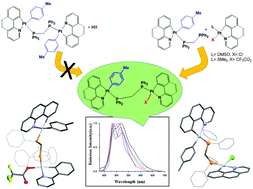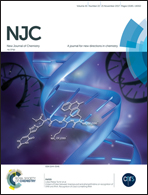Photophysical study on unsymmetrical binuclear cycloplatinated(ii) complexes†
Abstract
A general synthetic method has been designed to prepare a new series of unsymmetrical binuclear cyclometalated organoplatinum(II) complexes, each containing one bridging bis(diphenylphosphino)methane (dppm) ligand, one aryl group and one anionic X ligand. Thus, the reaction of [Pt(p-MeC6H4)(C^N)(η1-dppm)], in which C^N is either benzo[h]quinolinate (bhq), 2a, or 2-phenylpyridinate (ppy), 2b, with 1 equiv. of [Pt(C^N)(X)(S)] (C^N = bhq, X = CF3CO2, S = SMe2, 3a; C^N = ppy, X = CF3CO2, S = SMe2, 3b; C^N = bhq, X = Cl, S = DMSO, 3c), in CH2Cl2 gave complexes of the type [(p-MeC6H4)(C^N)Pt(μ-dppm)Pt(C^N)(X)], 5. Our attempts to synthesize complexes 5a and 5b by reaction of the corresponding symmetrical complex [(p-MeC6H4)(bhq)Pt(μ-dppm)Pt(bhq)(p-MeC6H4)], 4, with 1 equiv. of HX (X = Cl or CF3CO2) were unsuccessful and a mixture of unknown complexes was obtained. All the new complexes were fully characterized using multinuclear (1H and 31P) NMR spectroscopy and elemental analysis. The typical binuclear complexes [(p-MeC6H4)(bhq)Pt(μ-dppm)Pt(bhq)(Cl)], 5a, and [(p-MeC6H4)(bhq)Pt(μ-dppm)Pt(ppy)(CF3CO2)], 5c, were further characterized by single crystal X-ray crystallography. Photophysical properties of all the complexes were studied and the influence of changing their ligands on their luminescence properties was investigated and the assignments were confirmed by TD-DFT calculations.



 Please wait while we load your content...
Please wait while we load your content...